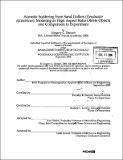| dc.contributor.advisor | Timothy K. Stanton and Andone C. Lavery. | en_US |
| dc.contributor.author | Dietzen, Gregory C | en_US |
| dc.contributor.other | Woods Hole Oceanographic Institution. | en_US |
| dc.date.accessioned | 2009-06-30T17:12:09Z | |
| dc.date.available | 2009-06-30T17:12:09Z | |
| dc.date.copyright | 2008 | en_US |
| dc.date.issued | 2008 | en_US |
| dc.identifier.uri | http://hdl.handle.net/1721.1/46059 | |
| dc.description | Thesis (S.M.)--Joint Program in Oceanography/Applied Ocean Science and Engineering (Massachusetts Institute of Technology, Dept. of Mechanical Engineering; and the Woods Hole Oceanographic Institution), 2008. | en_US |
| dc.description | Includes bibliographical references (p. 145-149). | en_US |
| dc.description.abstract | Benthic shells can contribute greatly to the scattering variability of the ocean bottom, particularly at low grazing angles. Among the effects of shell aggregates are increased scattering strength and potential subcritical angle penetration of the seafloor. Sand dollars (Dendraster excentricus) occur commonly in the ocean and have been shown to be significant scatters of sound. In order to understand more fully the scattering mechanisms of these organisms, the scattering from individual sand dollars was studied using several methods. Using an approximation to the Helmholtz-Kirchhoff integral, the Kirchhoff method gives an analytic integral expression to the backscattering from an object. This integral was first solved analytically for a disk and a spherical cap, two high aspect ratio oblate shapes which simplify the shape of an individual sand dollar. A method for solving the Kirchhoff integral numerically was then developed. An exact three dimensional model of a sand dollar test was created from computed tomography scans. The Kirchhoff integral was then solved numerically for this model of the sand dollar. The finite element method, a numerical technique for approximating the solutions to partial differential equations and integral equations, was used to model the scattering from an individual sand dollar as well. COMSOL Multiphysics was used for the implementation of the finite element method. Modeling results were compared with published laboratory experimental data from the free field scattering of both an aluminum disk and a sand dollar. Insight on the scattering mechanisms of individual sand dollar, including elastic behavior and diffraction effects, was gained from these comparisons. | en_US |
| dc.description.statementofresponsibility | by Gregory C. Dietzen. | en_US |
| dc.format.extent | 149 p. | en_US |
| dc.language.iso | eng | en_US |
| dc.publisher | Massachusetts Institute of Technology | en_US |
| dc.rights | M.I.T. theses are protected by
copyright. They may be viewed from this source for any purpose, but
reproduction or distribution in any format is prohibited without written
permission. See provided URL for inquiries about permission. | en_US |
| dc.rights.uri | http://dspace.mit.edu/handle/1721.1/7582 | en_US |
| dc.subject | /Woods Hole Oceanographic Institution. Joint Program in Oceanography/Applied Ocean Science and Engineering. | en_US |
| dc.subject | Mechanical Engineering. | en_US |
| dc.subject | Woods Hole Oceanographic Institution. | en_US |
| dc.subject.lcsh | Dendraster excentricus Acoustic properties | en_US |
| dc.subject.lcsh | Sound-waves Scattering | en_US |
| dc.title | Acoustic scattering from sand dollars (Dendraster Excentricus) : modeling as high aspect ratio oblate objects and comparison to experiment | en_US |
| dc.type | Thesis | en_US |
| dc.description.degree | S.M. | en_US |
| dc.contributor.department | Joint Program in Oceanography/Applied Ocean Science and Engineering | en_US |
| dc.contributor.department | Woods Hole Oceanographic Institution | en_US |
| dc.contributor.department | Massachusetts Institute of Technology. Department of Mechanical Engineering | |
| dc.identifier.oclc | 374508660 | en_US |
